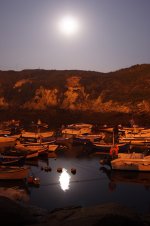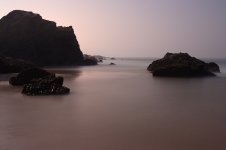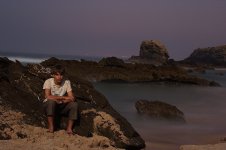pedro.m.reis
Newbie but eager to learn
Hi.
I wanted for a very long time to experiment in long exposures.
Got me a cheapo tripod and tested with the DSLR to see what i could have on film.
For the first test i think i got some nice results http://www.flickr.com/photos/pedromreis/sets/72157594255059740/ but i didnt got a well defined moon, kinda difused Whats the problem? Shake on the tripod?
I wanted for a very long time to experiment in long exposures.
Got me a cheapo tripod and tested with the DSLR to see what i could have on film.
For the first test i think i got some nice results http://www.flickr.com/photos/pedromreis/sets/72157594255059740/ but i didnt got a well defined moon, kinda difused Whats the problem? Shake on the tripod?
pedro.m.reis
Newbie but eager to learn
ChrisN
Striving
Very nice work, Pedro. I like the seascapes.
For the moon, the problem is over-exposure! The moon is light grey dirt, in full sun, so the sunny-16 rule applies! Of course, this will give you a good exposure of the moon but an under-exposure of the landscape. Try make two separate exposures, one for the moon ad one for the landscape, then combine them in photoshop.
For the moon, the problem is over-exposure! The moon is light grey dirt, in full sun, so the sunny-16 rule applies! Of course, this will give you a good exposure of the moon but an under-exposure of the landscape. Try make two separate exposures, one for the moon ad one for the landscape, then combine them in photoshop.
pedro.m.reis
Newbie but eager to learn
Thanks Chris, i'll try that.
The combining in photoshop is don with the HDR function right? ?'ve never try it....
So, its impossible to get this kind of shots in film.....
The combining in photoshop is don with the HDR function right? ?'ve never try it....
So, its impossible to get this kind of shots in film.....
ChrisN said:Very nice work, Pedro. I like the seascapes.
For the moon, the problem is over-exposure! The moon is light grey dirt, in full sun, so the sunny-16 rule applies! Of course, this will give you a good exposure of the moon but an under-exposure of the landscape. Try make two separate exposures, one for the moon ad one for the landscape, then combine them in photoshop.
pedro.m.reis
Newbie but eager to learn
Haaa.
Graduated filters are those that the top half is ND and bottom half dont right?
I see your point .
.
Thanks
Graduated filters are those that the top half is ND and bottom half dont right?
I see your point
Thanks
greyhoundman said:No, it's not impossible to do on film. A set of graduated ND filters will allow you to adjust for the bright moon.
Bryce
Well-known
The full moon is best exposed at sunny 16, since it's lit by direct sunlight... So you'll need a very strong split N.D. filter to expose it and the ground at the same time. Doing this will also yield an unnaturally dark sky.
Next, for exposures of more than a second or two with lenses long enough to show the moon as more than a dot, the image will start to "star trail" because the earth is rotating underfoot.
Next, for exposures of more than a second or two with lenses long enough to show the moon as more than a dot, the image will start to "star trail" because the earth is rotating underfoot.
kaiyen
local man of mystery
You don't have to use HDR to combine the two. Just take two shots and copy/paste the moon from one tot he other.
allan
allan
Share:



